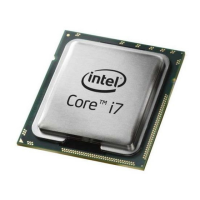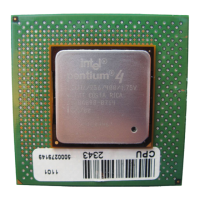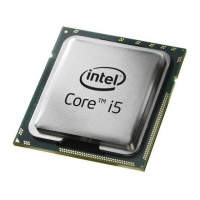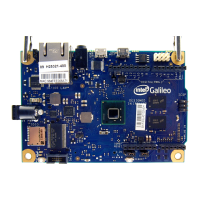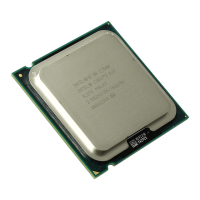LGA2011-0 Socket and ILM Electrical, Mechanical, and Environmental Specifications
40 Thermal/Mechanical Specifications and Design Guide
5.3 Loading Specifications
The socket will be tested against the conditions listed in Chapter 9, “Quality and
Reliability Requirements” with heatsink and the ILM attached, under the loading
conditions outlined in this chapter.
Tab l e 5 -3 provides load specifications for the LGA2011-0 socket with the ILM installed.
The maximum limits should not be exceeded during heatsink assembly, shipping
conditions, or standard use condition. Exceeding these limits during test may result in
component failure. The socket body should not be used as a mechanical reference or
load-bearing surface for thermal solutions.
Notes:
1. These specifications apply to uniform compressive loading in a direction perpendicular to the IHS top
surface.
2. This is the minimum and maximum static force that must be applied by the heatsink and its retention
solution at Beginning of Life (BOL).
3. Loading limits are for the LGA2011-0 socket.
4. This minimum limit defines the compressive force required to electrically seat the processor onto the socket
contacts.
5. Dynamic loading is defined as an 11 ms duration average load superimposed on the static load
requirement.
6. Test condition used a heatsink mass of 600gm [1.32 lb.] with 50 g acceleration measured at heatsink mass.
The dynamic portion of this specification in the product application can have flexibility in specific values, but
the ultimate product of mass times acceleration should not exceed this dynamic load.
7. Conditions must be satisfied at the beginning of life (BOL) and the loading system stiffness for non-
reference designs need to meet a specific stiffness range to satisfy end of life loading requirements.
8. These loading values are preliminary and subjected to change.
9. End of Life (EOL) minimum heatsink static load. The methods and techniques to evaluate heat sink EOL
load are included in Appendix F.
10. Beginning of Life (EOL) heat sink load. The methods and techniques to evaluate heat sink BOL load will be
included in a later release of this document.
11. The maximum mass includes all components in the thermal solution. This mass limit is evaluated using the
POR heatsink attached to a PCB.
12. The minimum BOL load is for guidance only. Thermal solutions must satisfy the EOL minimum load to be
compliant to the speicification.
5.4 Electrical Requirements
LGA2011-0 socket electrical requirements are measured from the socket-seating plane
of the processor to the component side of the socket PCB to which it is attached. All
specifications are maximum values (unless otherwise stated) for a single socket
contact, but includes effects of adjacent contacts where indicated.
Table 5-3. Socket and ILM Mechanical Specifications
Parameter Min Max Notes
Static compressive load from ILM cover to
processor IHS
445 N [100 lbf] 712 N [160 lbf] 3, 4, 7, 8
Heatsink Static Compressive Load BOL
222 N [50 lbf] 356 N [80 lbf]
1, 2, 3, 4, 8,
10, 12
Heatsink Static Compressive Load EOL
133 N [30 lbf] 356 N [80 lbf] 1, 3, 4, 8, 9
Dynamic Load (with heatsink installed)
N/A 589 N [132 lbf] 1, 3, 5, 6, 8
Pick and Place Cover Insertion / Removal force
N/A 6.2 N [1.7 lbf] 8
Load Lever actuation force
N/A
31 N [7.0 lbf] in the
vertical direction
8
Maximum heatsink mass
N/A 600g 11
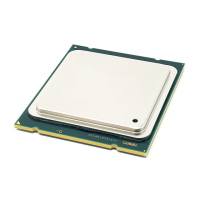
